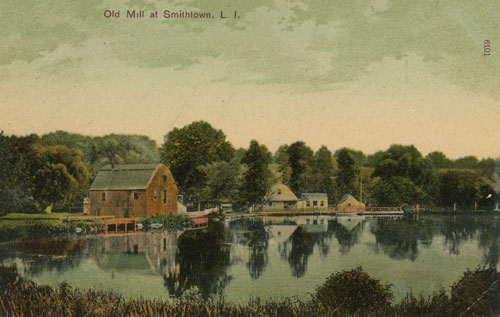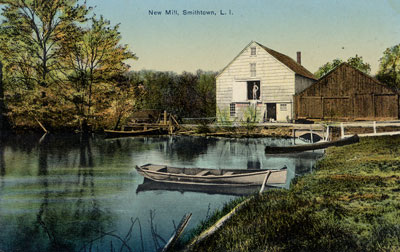Date unknown. Morgan Blydenburgh's photo of Widow Blydenburgh's Inn and Tavern. It was located where the main branch of the Smithtown Library standds today. Credit maggieblanck.com
Posted on 02/23/2011 8:47:40 AM PST by Pharmboy
Residents of Smithtown were proud patriots during the Revolutionary War.
During the Revolutionary War, from 1776 to 1783, Smithtown was under British occupation. Residents suffered poverty, destruction and the loss of property and loved ones at the hands of British soldiers and loyalists.
Smithtown historian Bradley Harris said one-third of Long Islanders were loyalists, one-third patriots and one-third neutral. Most loyalists were found in Nassau, and the majority of those who were neutral were Quakers. According to the historian, Suffolk County is where you found the majority of patriots.
As for one’s alliance, Harris said, “Where you were on Long Island made a difference.”
After the Battle of Long Island in 1776, the British occupied the island including Smithtown. According to Harris, residents’ homes were raided by soldiers and loyalists. There were also threats to their lives if they didn’t pledge their allegiance to the King of England.
Smithtown’s Ruth Blydenburgh, a widow, was not intimidated. Harris said when soldiers came to her tavern demanding food and drink; she told them not to bother a poor widow and sent them to the tavern of Epenetus Smith.
Date unknown. Morgan Blydenburgh's photo of Widow Blydenburgh's Inn and Tavern. It was located where the main branch of the Smithtown Library standds today. Credit maggieblanck.com
While Smith may have served them that day, he too was a patriot. He circulated a log asking Smithtown residents to note what the soldiers and loyalists stole from them with the intent of being reimbursed one day. According to the historian, items such as hay, Indian corn, wheat as well as supper plates, cut glasses and petticoats were listed.
Epenetus Smith's Tavern can still be found today on the property of the Smithtown Historical Society on Middle Country Road. Credit Rita J. Egan
A devout patriot was Caleb Smith I, whose house still stands today at Caleb Smith State Park Preserve. Smith refused to give up his money and silver to the British and buried it on his property. Harris said soldiers and loyalists chased Smith around Willow Pond, slashed him with hickory gads, destroyed his furniture and abused his family, but he would not give up.
Today a door is displayed at the park’s museum that Smith used to shield himself from his enemy’s cutlass. The mark left on the door by the weapon is still visible today.
The house of Caleb Smith I still stands today at Caleb Smith State Park Preserve located on Jericho Turnpike. Credit Michael D'Agostino
Zephaniah Platt of the Fort Salonga area provided a hideout for whaleboat raiders. According to Harris, the raiders would place cannons on whaleboats and go out on the water to attack the British. In the end of 1777, the British burned the hidden whaleboats and sent Platt, who was over 70 years old, to a prison ship in New York City. Platt was rescued by his daughter but died a few days later.
The name Fort Salonga comes from the British Fort Slongo that once stood there. In October of 1781 General George Washington decided an attack on the fort was needed to delay a British assault on New York City. The fort was burned down and twenty British soldiers were captured.
As for Washington, he never slept in Smithtown. However, according to Harris, he did stop in our town in 1790 during a Presidential visit. Washington was on his way back from Setauket and stopped at Widow Blydenburgh’s to rest and feed his horses.
While his visit to Smithtown was a short one, Washington was in a town where many remained dedicated patriots despite adversity during the war. These patriots are still remembered today.
I love Long Island. From it.

Smithtown, LI, is about 60 miles from where the Battle of LI took place, but what else would I use as a graphic for this story?
And, the Brits kicked our butts during this, but Washington learned a lot.
The RevWar/Colonial History/General Washington ping list...
We’ve been to the historic places in Smithtown. My sister lived there, we’ve been on the Island since 1980.
I love my Long Island, but these a@@hats in charge are forcing us to move.
I hate that!


I grew up on LI (early fifites - now). As soon as my wife is vested in her pension we are gone.
Indeed...agree on both counts. The beaches out in the east end are some of the most beautiful in the northeast...or perhaps the east coast. Those @sshats have caused one of the wealthiest counties in the country (Nassau) to go broke...when will they ever learn?
Once again, thanks for your additions.
I thought I wanted to live there for a while but now it’s inhabited by ultra-liberals that keep people like Tim Bishop in office. I will never live there now.
Nassau is a complete mess, as it has been for years. Why on earth these morons keep electing them is beyond my comprehension.
Have you noticed Nassau looks more and more like Queens and the other boroughs? Seems like they’re moving in and taking over inch by inch.
Suffolk hasn’t been affected as much as Nassau, but the illegals here and their gangs seem to be taking over.
I am truly sad I have to leave my Long Island, but I have no choice.
I’ve lived on LI my whole life - only a few minutes from Smithtown for most of it. Been to the places shown above several times. There’s a rich, patriotic history here!
Long Island rocked back in the days! Now the boroughs seem to be creeping in, inch by inch. Time for us normal red folk to get the heck out!
This ex-Long Islander (Greenlawn) give thanks for the interesting post.
LI started going to hell when the aforementioned white flighters took advantage of depressed real estate values in the 1970s and turned Nassau and parts of Suffolk into Bensonhurst with grass. Other than the South Shore beaches, my old home has no redeeming values, and the QOL in the city is better these days anyway.
Disclaimer: Opinions posted on Free Republic are those of the individual posters and do not necessarily represent the opinion of Free Republic or its management. All materials posted herein are protected by copyright law and the exemption for fair use of copyrighted works.